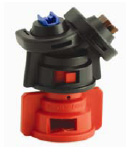Choosing the right type of sprayer nozzle can mean the difference between a 50% increase in yields or a 50% decline.
An agricultural tool as small as a thumb can mean the difference between a 25 to 50% increase in yields or a 25 to 50% decline, according to an expert from Ohio State University’s College of Food, Agricultural, and Environmental Sciences.
Choosing the right type of sprayer nozzle can make a huge difference in how effective pesticides are during a growing season and whether growers have to re-spray their fields or in some cases, replant, said Erdal Ozkan, an agricultural engineering professor and spray technology expert with Ohio State University Extension and the Ohio Agricultural Research and Development Center (OARDC).
OSU Extension and OARDC are the outreach and research arms, respectively, of the college.
Not only do farmers have to have a field clear of weeds and pests before they plant, they have to keep that field free of pests and weeds throughout the growing season, Ozkan said. And with the rising cost of pesticides and fertilizers, growers who also want to save money and spray chemicals as efficiently as possible need to make sure they choose the correct spray nozzle for their fields, weather conditions and type of chemicals they apply, he said.
“Farming is a tough business, with a very narrow margin between profit and loss,” Ozkan said. “So anything we can do to widen that margin is a good thing.”
The costs are significant. Farmers spend approximately $4.1 billion on pesticides annually, according to published reports. And large self-propelled sprayers can cost more than $250,000, according to the EPA.
“Growers usually choose pesticides based on their effectiveness, not how much they cost,” Ozkan said. “So one way to find savings in crop production is how we apply pesticides, and choosing the right nozzle is a part of that process.
“The more precise and accurate growers are in their applications, the more growers can have a net savings. For example, if growers are spraying more than the recommended rate, it is a waste of money.”
National surveys of field application results have shown that only about one out of three sprayers are applying pesticides at the recommended rates, while two-thirds are missing the mark by either over- or under-spraying, Ozkan said.
“Doing it right can result in better control and cost savings, and eliminates having to do a second application,” he said. “If you don’t do it right or choose the wrong nozzle, the mistakes won’t show up that day, but sometime later in the growing season when weeds, insects, disease or all of the above start showing up in the crops in particular areas.”
Ozkan said growers can improve the performance of sprayers if they:
- Always calibrate the equipment with water before spraying to ensure that the sprayer is applying the chemical at the recommended rate. (For details, see the OSU Extension fact sheet “Boom Sprayer Calibration”).
- Mix chemicals in a small container before pouring them into the sprayer tank to achieve a uniform mix.
- Determine if the pesticide requires specific adjuvants to provide product efficacy, influence droplet size or solution evaporation rate, reduce drift and to improve deposit and retention on the target.
- Understand that some pesticides are volatile and may require incorporation into the soil after application.
- Check sprayer components to ensure they are the right size and type; check the sprayer system for leaks; and check the tank agitation system to ensure that flow to the tank for agitation is effective.
- Make sure pressure gauge on the sprayer is accurate and operate the sprayer within the pressure range recommended by the nozzle manufacturer.
- Keep the boom height to a minimum to reduce drift. Setting the proper boom height for a given nozzle spacing is extremely important in achieving proper overlapping. Conventional flat-fan nozzles require 30- to 50% overlapping of adjacent spray patterns. Check catalogs for specific recommendations for different nozzles.
- Maintain uniform deposition of spray material on the target across the boom. Non-uniform coverage can result from using misaligned or clogged nozzles, nozzles with different fan angles, or from uneven nozzle height across the boom. This can result in streaks, untreated areas or over-application of chemicals.
- Watch for pattern streaks in the nozzle output, which indicate particles are in the nozzles. Remove them from the nozzle tip using a wooden toothpick or soft object and clean the nozzle filter using a soft brush.
- Learn more about reducing spray drift as much as possible.
Source: Ohio Ag Connection
Shop Ag Spray Parts with Agrimart.net

